14 Types of Clams to Grace Your Seafood Platter
Author: Anne Cowart | Editor: Omar Alonso
Review & Research: Jen Worst & Chris Miller
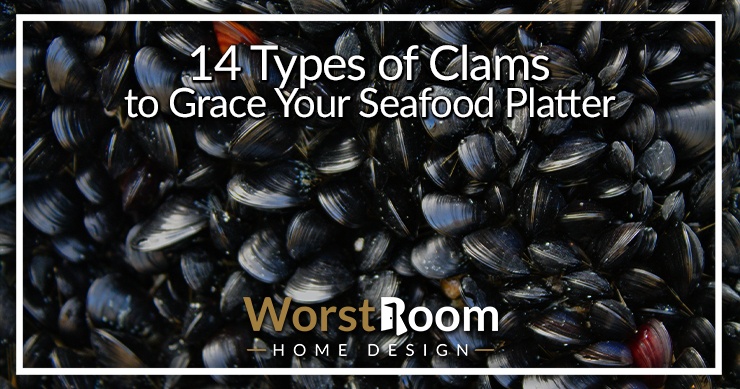
Though all the different types of clams are among the easiest seafood to cook, nothing about their sizes, colors, and names is easy, especially because there are quite a few to learn about.
But if you love eating this bi-valve, the variety will only make you happier — so many different kinds of clams to taste and feast on! Stuffed, fried, steamed, or in a chowder, here are the clam varieties that can go on your plate.
14 Types of Clams
Who'd have thought there'd be this many different kinds of clams that you can prepare in a handful of various ways. Multiply all that together and there's endless ways to enjoy this favorite seafood option. Let's dig in.
Geoduck
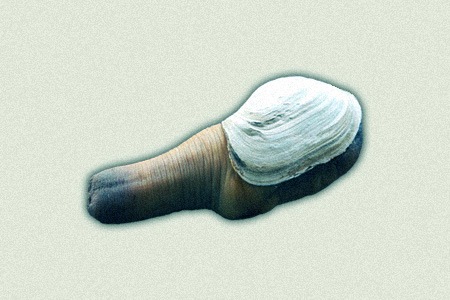
With a funny shape (elephant trunk or phallus, depending on how you want to look at it) and a funnier name (it’s pronounced ‘gooey-duck’), geoducks are beloved for their naturally salty flavor and meat that’s somehow crunchy and chewy at the same time! From Asia to the Pacific Northwest, you’ll find geoducks devoured as a delicacy.
There are two major types of geoducks—the Atlantic geoducks or P. bitruncata and the Pacific geoducks or Panopea generosa.
The former is commonly found near Atlantic shorelines spanning from the Gulf of Mexico to North Carolina. Though they’re a separate species, these geoducks are almost exactly like their Pacific cousins.
The latter, the Pacific geoduck clam types, are commonly found on the coasts between Baja California and southern Alaska.
Both types of geoducks have cylindrical, white-colored shells, with the shell size being anywhere between seven and nine inches.
These clams also have a four-foot outer siphon that’s typically savored raw, in thin slices, or over specific types of sushi. The stronger flavor in the belly area means that the portion is generally used to flavor broths or is best eaten lightly fried.
With a single geoduck weighing up to a whopping eight pounds, these clams are the largest tunneling clam species and also among the most expensive.
Cockles
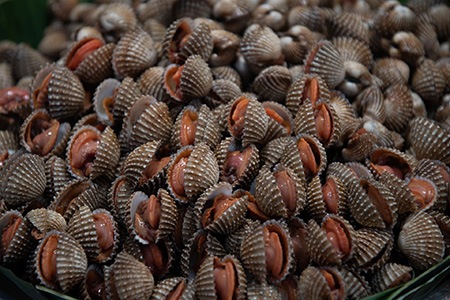
Delicate, slightly sweet, and extremely delicious, cockles are small bi-valves that are commonly found in New Zealand, Spain, the Gulf of Mexico, New England, and the US West Coast.
These types of clams are relished in pasta and all types of pasta sauce and the best part is that cooking them is a matter of seconds.
Some people don’t regard cockles as varieties of clams, since they’re not as classy as their counterparts and are more cheaply and commonly found, cockles do belong to the clam family. They even have nearly the same physical shell structure, with variations limited to the patterns on their shells.
However, despite the many cockle breeding grounds in the United States, cockles are quite rare in a commercial context, with most of the country’s cockles being imported in cans from New Zealand or Spain’s farms.
Though you can enjoy these raw, try them in an Asian-style laksa, or just subtly steamed and accompanied by lemon and butter.
Razor Clams
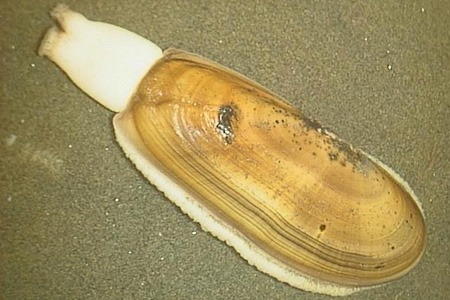
If you’re new to navigating the clam family, you can be forgiven for overlooking razor clams as a member. These straight, razor-like clams don’t look anything like their round cousins, but are every bit as delicious, with a subtler flavor and meaty texture.
There are two main clams in this family (the Solenidae family)—Atlantic razor clams (Ensis directus or Ensis leei), also referred to as Atlantic jackknives, and the Pacific razor clams (Siliqua patula), also referred to as northern razor clams.
Pacific razors are ovular, with lengthy siphons that jut out quite a bit. Atlantic razor clams are milder, rarer, sweeter, and thinner than Pacific razors, with a maximum shell length of eight inches. Given how delicate their shells are, cleaning jackknives can be quite challenging, which is why many folks prefer to not cook these at home.
Both Pacific and Atlantic razor clams are best enjoyed lightly seared, grilled, or steamed, with a mild sauce that doesn’t overpower their natural flavors. You can also eat them raw as ceviche due to the tenderness of the meat and use them in stuffing, baking, and broiling, too.
Though both are grouped together as razor clams, bear in mind that Pacific and Atlantic razor clam types are two completely different clam species with many differences between them.
Steamers
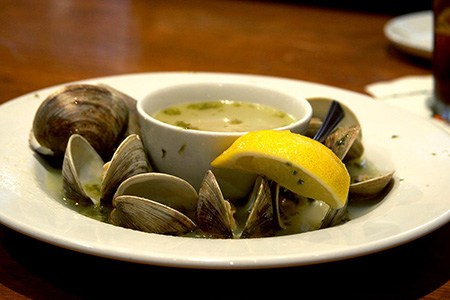
These types of clams are of the soft-shelled variety, which is why they’re also commonly referred to as soft-shell clams (along with pisser clams, longnecks, and Ipswich clams).
Though their shells are softer than other clam varieties, steamer clams’ outers are still quite hard and brittle, requiring you to shuck the meat out before cooking it. The tender meat is a perfect mix of sweet and salty and is best enjoyed lightly steamed with a butter sauce and fine wine for company, or fried whole, the true Ipswich way.
Another traditional way that these clams are served is to steam the clams whole, drain them, and provide diners with clarified butter and a cup of the drained water, so that they may use the water to rinse off any excess grit and then enjoy the meat dipped in butter.
It’s highly essential that you properly de-grit these clams before cooking them, as they have protruding siphons that prevent them from closing their shells completely. They also tend to burrow quite deep, so the amount of grit that you find in them can be quite higher than in other clam varieties.
Steamer clams are most commonly found along the New England coastline and can be served with all manner of seafood like various types of oysters, types of shrimp, fish, and of course, hush puppies.
Hard Shell Clams
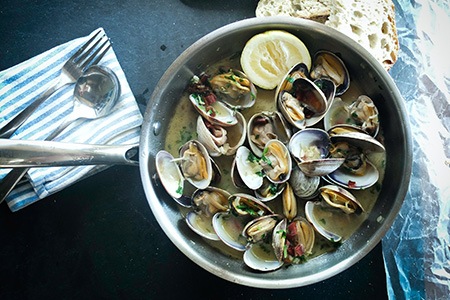
Known by many names, hard shell clams are often the cause of much confusion and debate among clam connoisseurs.
The fact is that there are different varieties of clams, segregated by size, that belong to the hard shell clam family, and hence, the many names. For convenience, it’s easiest to segregate hard shell clams into the southern and northern varieties.
Scientifically known as Mercenaria mercenaria and informally as quahogs (after poquauhock, a Narragansett word), the hard shell clam family consists of littlenecks, topnecks, cherrystones, chowders, and Mahogany clams.
Littlenecks, topnecks, cherrystones, and chowder are all northern quahogs, commonly found in the waters between the Gulf of Mexico and the Gulf of Saint Lawrence. Let's talk a little about each of these below.
Littleneck Clams
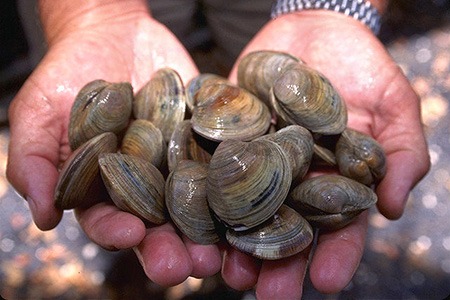
Littleneck clams are the smallest in the family, named after Long Island’s Little Neck Bay. Though small, they’re favored for their sweet, tender meat, often eaten raw from the shell or steamed and added to salads, pasta, and sauces. Littlenecks are usually 1.5 inches in width.
Topneck Clams
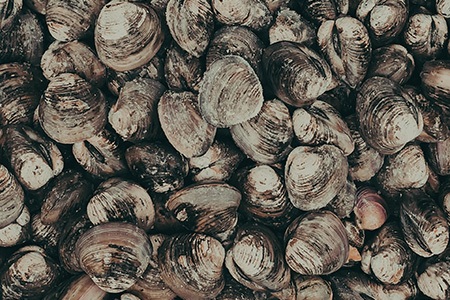
Topnecks or middlenecks are the next biggest, measuring around two inches in width. These types of clams are also quite tender, so they can be enjoyed raw or steamed, but they’re large enough to allow grilling in any types of grills, as well.
Cherrystone Clams
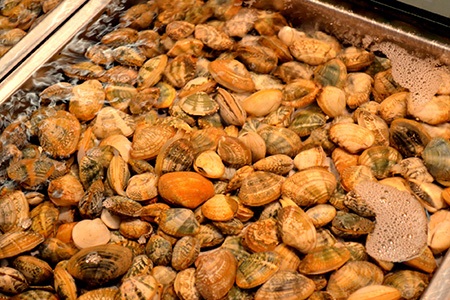
Cherrystones succeed middlenecks, at their tastiest when eaten broiled, stuffed, grilled, or raw. These clams are about 2.5 inches in width. You can really boost the experience by using the right types of forks (that's right, there is such a thing as an oyster fork).
Chowder Clams
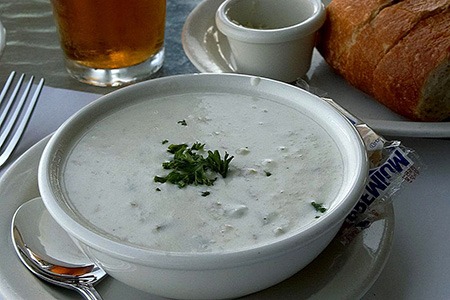
Chowders are the largest in the northern quahog family, over three inches in width. Their slightly tough meat makes them unideal for consuming raw, so they’re best enjoyed completely cooked or in the famed chowder.
Quahog Clams
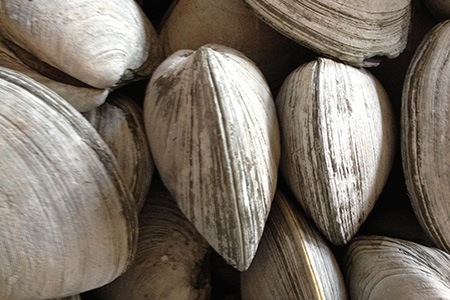
Coming to the Southern variety, these quahogs (also known scientifically as M. campechiensis), occupy the waters from the West Indies to the Chesapeake Bay; otherwise, they’re pretty similar to their northern counterparts.
Mahogany Clams
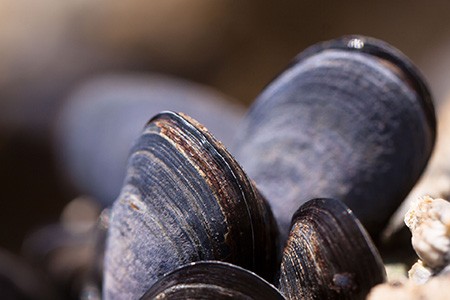
The last of the hard shell clam types are Mahogany clams, commonly found in the waters around Maine. They’re also locally referred to as ocean quahogs and are different from both northern and southern quahogs—they have black or extremely dark brown shells that are round and they tend to reside deeper in the water than other clams.
These clams also have a much bolder flavor. Since these different kinds of clams take a longer time to mature than other types, these clams can be quite seasonal.
Manila Clams
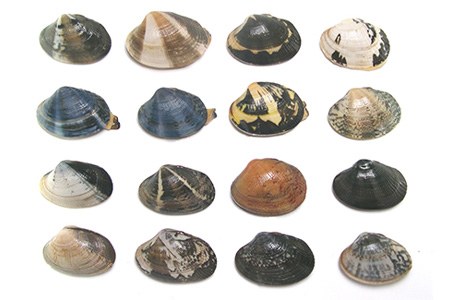
Though they’re hard-shelled, Manila clams do not belong to the quahog family as their shells are much thinner. Some folks refer to Manila types of clams as steamers too, like soft-shell clams, because they’re eaten similarly.
Manila clams, known scientifically as Venerupis philippinarum and informally as asari (from their Japanese names), are abundantly found in the country’s West Coast region. The meat is quite sweet and can be enjoyed in pasta, steamed, or raw.
Surf Clams
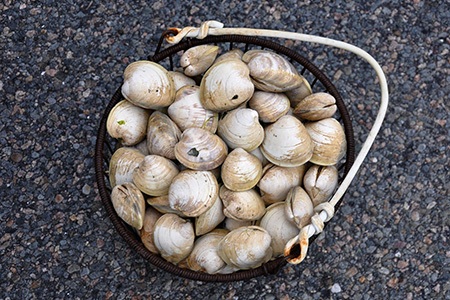
Spisula solida are six-inch clam varieties that are a godsend for clam chowder lovers. Primarily found in the deep waters near New Jersey’s coastline, surf clams account for almost 30% of the clams harvested in the country.
Washington Clams
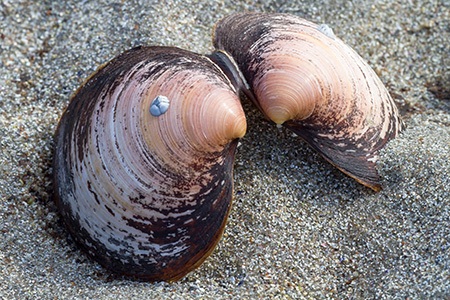
You'll sometimes see these called "Butter Clams" on menus, so keep your eyes peeled. They're called such due to their very soft texture that "melts like butter" and goes well with butter actually. People enjoy them steamed or grilled, which are your usual two options when ordering.
Some chefs like to bust these into two categories that include Northern Washington Clams (S. giganteus) and Southern Washington Clams (S. nutalli). The northern ones are fished up between California and Alaska and come in around 4 inches in diameter. The southern clams are found on the coast of western Mexico and come in at a staggering 7 inches in diameter.
Types of Clams to Grace Your Taste Buds
Yes, there’s more than one clam species and you can eat clams in more ways than just chowder. Clams are among the most loved seafood in the world, featuring widely on home dining tables and in gourmet restaurants alike.
The meat is quite versatile, used in a range of dishes around the world, from pasta, sauces, and chowder to region-specific specialties such as southeast Asia’s Com Hen and Italy’s spaghetti alla vongole—or simply savored raw, with a dash of lime, herbs, and butter.
If you’re a fan of all the different types of clams, we definitely suggest keeping this list handy and ticking off your clam endeavors.




